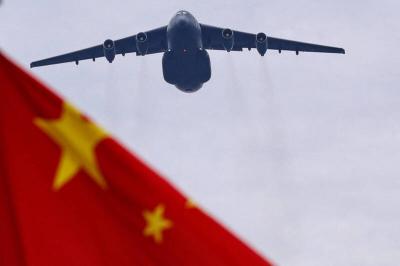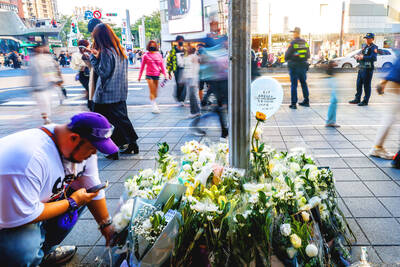When Next Media launched its “News-in-Motion” feature on the Chinese-language Apple Daily Web site last week, it was considered by some a novelty, a harbinger of animated news in Taiwan.
Within a week, however, it had managed to upset children’s and women’s rights groups, while others deemed it a challenge to the limits of freedom of expression.
The sensational content and graphic animation compelled representatives from 15 advocacy groups to stage a protest outside Next Media’s headquarters on Thursday to express their disapproval. On the same day, Taipei Mayor Hau Lung-bin (郝龍斌) fined the company NT$500,000 for the second consecutive day, accusing it of violating the Children and Juvenile Welfare Act (兒童及青少年福利法).
As the Apple Daily provides a barcode allowing access to “News-in-Motion,” schools in Taipei City have been ordered to cancel their subscriptions, while students and teachers have been asked not to bring the paper to schools. Computers on school campuses also blocked the IP addresses of “News-in-Motion” and residents of the city are now required to present their ID to be allowed to read the paper at city libraries.
The controversy surrounding “News-in-Motion” has placed tremendous pressure on the National Communications Commission (NCC), which is in the process of reviewing the group’s application to establish the Next TV network. The applications include plans for “News-in-Motion” to feature on its news channel.
NCC spokesperson Chen Jeng-chang (陳正倉) said that Next TV’s chances of securing an operating license for its news and information channels are very low, especially in the wake of the “News-in-Motion” scandal.
Chen said that the commission would review the three other channels that the group intends to set up — entertainment, sports and movie channels — this week, adding that commissioners are likely to approve them as they are “less controversial.”
Some view “News-in-Motion,” as well as the warnings issued by civic groups, as part of a plan weaved by Next Media Group chairman Jimmy Lai (黎智英), who has spent more than NT$1 billion (US$30 million) on the project.
Professor Hung Chen-ling (洪貞玲), of the Graduate Institute of Journalism at National Taiwan University, said the Apple Daily is known for complementing its crime stories with cartoons to help readers form a better impression of the scene.
“The response the newspaper has received over the years convinced Next Media that the same thing might also work on TV with animated news,” Hung said. “So ‘News-in-Motion’ was launched to test reactions from the market and the company will simply change direction if that backfires.”
The style of animation, however, received mixed reaction from professional animation producers and media researchers.
“In simulating a homicide, do we really have to tell the audience how the victim was cut to pieces or how blood was spattered at the crime scene?” asked Fong Tsai-shin (方彩欣), assistant professor in the Department of Applied Arts at Fu Jen Catholic University.
Fong also called for caution over the use of animated news.
“Words and images are different,” she said. “People can imagine the scene with the words they read, but when you show them the images, the imagination is gone. They begin to see it as fact.”
“When reporters give instructions to [animation] artists about what they want to show, they might also be adding some personal interpretations,” she said. “The amount of detail shown in animation could be determined by the kind of headlines they want the story to have.”
Fong said that animation can be used to enhance storytelling in certain types of news, such as those introducing a new technology. Even so, she said that reporters are not necessarily technology experts and are likely to provide wrong information. Besides, the quality of animated news may also be questionable given the limited time that animation artists have to reproduce the details and deliver their representations, she said.
Lai recruited King Pu-tsung (金溥聰), former Taipei City Government spokesperson, as CEO of Next TV because of King’s background in journalism. King, however, held the position for just four months and left in June. He said in an interview with the United Daily News that he did not agree with the use of animation to cover crime stories.
Chiang An-kuo (蔣安國), an associate professor at Fo Guang University, said he did not agree with NCC Chairwoman Bonnie Peng (彭芸) when she said that “News-in-Motion” is not news.
“To me, it is news, because it answers all the basic questions of news — who, what, where, when, why and how,” he said.
While he is aware that the NCC will soon address the concerns raised by the use of animated news, Chiang said it was important for the commission to shed its traditional mindset when dealing with emerging media.
“Animated news is a product of the multimedia age and the technology is [nothing more than] a tool,” he said, adding that we must avoid treating it as some “uncontrollable monster.”
Chiang said the problem with “News-In-Motion” is that it focuses on violence and sexual abuse, which is why advocates were offended.
“They [Next Media] simply have to adjust the content to meet public expectations,” he said.
Chiang said the NCC has neither the ability nor the time and resources to regulate the content of news media. The only thing the NCC can do is ask that media adhere to the rules.
Weber Lai (賴祥蔚), director of the Applied Media Arts Graduate Institute at National Taiwan University of Arts, said that in the short term the government could regulate animated news based on laws protecting women and children.
“The law almost always has to follow technology. Today it is animated news. Who knows what will come next? The commission can only stipulate some general guidelines to regulate new media content in the long run.”
As online content can be downloaded on cellphones, said Jason Lin (林一平), professor at National Chiao Tung University’s Department of Computer Science, the NCC must establish a rating system for online content.

Beijing could eventually see a full amphibious invasion of Taiwan as the only "prudent" way to bring about unification, the US Department of Defense said in a newly released annual report to Congress. The Pentagon's "Annual Report to Congress: Military and Security Developments Involving the People's Republic of China 2025," was in many ways similar to last year’s report but reorganized the analysis of the options China has to take over Taiwan. Generally, according to the report, Chinese leaders view the People's Liberation Army's (PLA) capabilities for a Taiwan campaign as improving, but they remain uncertain about its readiness to successfully seize

Taiwan is getting a day off on Christmas for the first time in 25 years. The change comes after opposition parties passed a law earlier this year to add or restore five public holidays, including Constitution Day, which falls on today, Dec. 25. The day marks the 1947 adoption of the constitution of the Republic of China, as the government in Taipei is formally known. Back then the Chinese Nationalist Party (KMT) governed China from Nanjing. When the KMT, now an opposition party in Taiwan, passed the legislation on holidays, it said that they would help “commemorate the history of national development.” That

Taiwan has overtaken South Korea this year in per capita income for the first time in 23 years, IMF data showed. Per capita income is a nation’s GDP divided by the total population, used to compare average wealth levels across countries. Taiwan also beat Japan this year on per capita income, after surpassing it for the first time last year, US magazine Newsweek reported yesterday. Across Asia, Taiwan ranked fourth for per capita income at US$37,827 this year due to sustained economic growth, the report said. In the top three spots were Singapore, Macau and Hong Kong, it said. South

HORROR STORIES: One victim recounted not realizing they had been stabbed and seeing people bleeding, while another recalled breaking down in tears after fleeing A man on Friday died after he tried to fight the knife-wielding suspect who went on a stabbing spree near two of Taipei’s busiest metro stations, Taipei Mayor Chiang Wan-an (蔣萬安) said. The 57-year-old man, identified by his family name, Yu (余), encountered the suspect at Exit M7 of Taipei Main Station and immediately tried to stop him, but was fatally wounded and later died, Chiang said, calling the incident “heartbreaking.” Yu’s family would receive at least NT$5 million (US$158,584) in compensation through the Taipei Rapid Transit Corp’s (TRTC) insurance coverage, he said after convening an emergency security response meeting yesterday morning. National